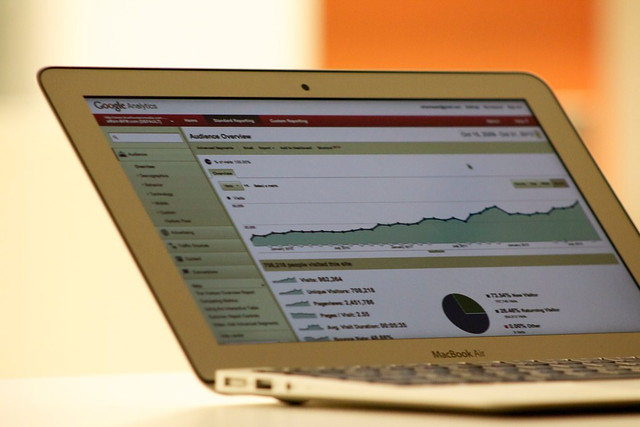
Photo source: Blue Fountain Media on
flickr.

Over the years, I have often heard the question "My
Google Analytics numbers don't match my web analytics numbers. Which one is
correct?" Well, the answer to that question is that
both are correct. But
how can that be possible?
It’s All About the Data Gathering Process
The explanation is that they use completely different
methods for gathering analytics information, since they are intended to be used
by different audiences for different purposes.
Google Analytics is most
commonly used by the Marketing team, who tracks metrics like page
views, unique visitors, traffic sources, pages per visit and bounce rate. Web
analytics, on the other hand, are used by the IT team, who are responsible for
server, bandwidth and resource utilization.
Call it the CMO vs. CIO divide!
How Google Analytics Gathers Data
Google Analytics uses a client-side technique for
gathering analytics. When an HTML page is sent your browser, it contains some
JavaScript code that is then executed by the browser, sending information to the
Google Analytics service.
Google Analytics is very effective at tracking page views
and unique visitors, but only for those web assets that can embed JavaScript
within their payload and are processed by a web browser. So, essentially only
web pages. Google Analytics
does not track analytics for resources such as
images, and videos. For marketing purposes, Google Analytics are especially
relevant because they represent engagement with real visitors to your site.
How Web Analytics Gathers Data
Conversely, web analytics use server-side techniques for
gathering analytics. When a web server receives a request for a web asset, it
records this information in a repository. Since it is responsible for
processing every type of request, it tracks information for every type of web
asset, including pages, images, videos, etc. This makes web analytics very
useful for IT professionals, as it allows them to analyze how various requests
are being handled and more easily
identify errors, configuration issues, and
performance problems.

One difference in these data gathering techniques is
related to non-human web requests. Although you usually only think of
engagement with real live visitors on your website, there are also other types
of automated visitors known as robots and spiders which interact with your
website on a regular basis.
A good example of this is
GoogleBot, which regularly
visits your site and indexes the content so that people can find you in the
Google search engine. When a robot or spider visits your site, it does not
process an HTML page the same way as a standard web browser.
Since a search engine’s primary focus is on content and
links, it is not interested in the visual rendering or functionality of the
page. So it
removes all scripts from the page, including HTML tags and
JavaScript. This means that requests from automated visitors will not be
recorded in Google Analytics, as the JavaScript will not be executed. However,
requests from robots and spiders are recorded in web analytics. This can lead
to some very significant discrepancies if you try to compare the two sets of
numbers, as your web analytics will always be significantly greater, sometimes
even 10x or more.
Photo source: User ares64 on
flickr.
A Look at Related Services
Confusion can also arise from other types of web services, as it really depends on how those services are implemented and
integrated into your website. The value that you get from most services is
usually based on some form of analytics, but since some rely on client-side
techniques to track analytics and others rely on server-side techniques, it
makes it really
difficult to correlate the results.
For example, if you post some content on a third party
service that contains a link to your website, you will be interested in knowing
how many times that link gets followed. However, it is not always obvious if
the third party service is using client-side or server-side techniques, if they
are including or excluding automated visitors, or if they have some proprietary
algorithm based on IP address or time span to prevent abuse of their service.
All of these factors can lead to a different tabulation of results.
Conclusion
So going back to the original question, it should be now
quite understandable why Google Analytics does not match your web analytics.
When it comes to analytics, you really need to understand how they are being
tracked and what they represent before you can use them effectively in your
business. It really comes down to choosing the right tool for your intended
purpose and remaining consistent over time, so that you can get the most value.
Related Reading
If you enjoyed this post about Google Analytics, you might like these blog posts about SEO:
- 10 Ways DNN Can Improve Your Website SEO
- Why Online Communities Help Lift SEO in a Google Hummingbird World